Biology 1/2 - Ecology
0.0(0)
Card Sorting
1/85
Study Analytics
Name | Mastery | Learn | Test | Matching | Spaced |
|---|
No study sessions yet.
86 Terms
1
New cards
Ecology
the study of the interactions of living organisms with one another and with their physical environment
2
New cards
organism
an individual living thing
ex. black bat
ex. black bat
3
New cards
population
all of the individuals of a species that live in the same area
ex. the black bats
ex. the black bats
4
New cards
community
a group of different species that live together in one area
ex. black bats, worms, moss, etc.
ex. black bats, worms, moss, etc.
5
New cards
habitat
place where an organism usually lives
ex. cave
ex. cave
6
New cards
ecosystem
the different species plus the environment; biotic factors and abiotic factors
ex. soil in that cave, light entering the cave, temperature in cave, humidity in cave, etc.
ex. soil in that cave, light entering the cave, temperature in cave, humidity in cave, etc.
7
New cards
biome
major regional or global community of organisms characterized by the climate conditions and the plant communities that thrive there
8
New cards
biotic factors
organisms in a habitat
9
New cards
abiotic factors
physical aspects of the habitat
10
New cards
biodiversity
the assortment or variety of living things in an ecosystem
11
New cards
biodiversity is threatened by
pollution
global warming
habitat destruction
global warming
habitat destruction
12
New cards
keystone species
a species that has an unusually large effect on its ecosystem
ex. sea otters
ex. sea otters
13
New cards
producers provide
energy for other organisms in an ecosystem
14
New cards
producer
organism that obtains energy from nonliving resources; organism that makes its own food
15
New cards
autotroph
another word for producer; self feeder
16
New cards
consumer
organism that gets its energy by eating other living or once living resources
17
New cards
heterotroph
another word for consumer; different feeder
18
New cards
producers are
basis for ecosystems energy
most rely on sunlight
almost all obtain energy from sunlight
photosynthesis
most rely on sunlight
almost all obtain energy from sunlight
photosynthesis
19
New cards
herbivores
organisms that eat only plants
ex. rabbits
ex. rabbits
20
New cards
carnivores
organisms that eat only animals
ex. snake
ex. snake
21
New cards
omnivores
organisms that eat both plants and animals
ex. chicken, humans
ex. chicken, humans
22
New cards
detritivores
organisms that eat dead, organic matter
ex. millipede
ex. millipede
23
New cards
decomposers
organisms that break down organic matter into simpler compounds
ex. fungi and bacteria
ex. fungi and bacteria
24
New cards
food chain
sequence that links species by their feeding relationships
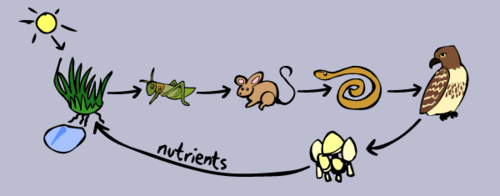
25
New cards
trophic levels
levels of nourishment in a food chain
ex. producer>herbivore>carnivore
ex. producer>herbivore>carnivore
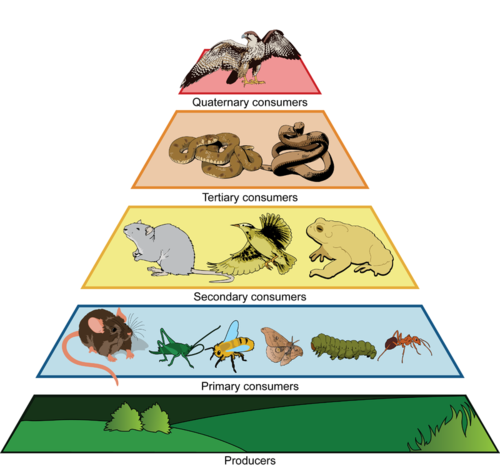
26
New cards
producers level
level 1 on the trophic levels
27
New cards
primary consumers level
level 2 on the trophic levels
herbivores and omnivores
herbivores and omnivores
28
New cards
secondary consumers level
level 3 on the trophic levels
carnivores and omnivores
carnivores and omnivores
29
New cards
tertiary consumers level
level 4 on the trophic levels
carnivores that eat carnivores and some omnivores
carnivores that eat carnivores and some omnivores
30
New cards
food web
model that shows the complex network of feeding relationships and the flow of energy within and sometimes beyond an ecosystem
31
New cards
pyramid models
an energy pyramid shows the distribution of energy among trophic levels
32
New cards
10% rule
at each trophic level, the energy stored is about 10% of that stores by the level below
33
New cards
biomass
measure of the total dry mass of organisms in a given area
incorporated into the body of a consumer
incorporated into the body of a consumer
34
New cards
energy pyramids
the longer a food chain, the more energy lost
diagram that compares energy used by producers, primary consumers, and other trophic levels
diagram that compares energy used by producers, primary consumers, and other trophic levels
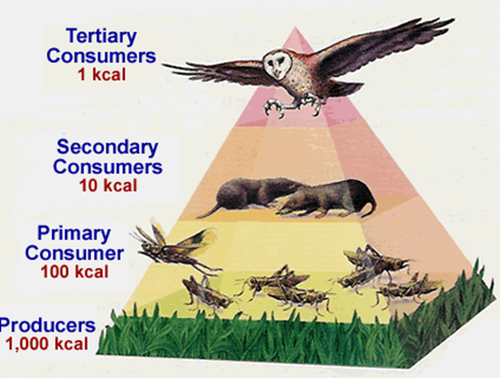
35
New cards
ecological niche
how an organism lives in its habitat
-includes all of the physical, chemical, and biological factors that a species needs to survive, stay healthy and reproduce
-includes all of the physical, chemical, and biological factors that a species needs to survive, stay healthy and reproduce
36
New cards
competition
when 2 organisms fight for the same limited resource
37
New cards
predation
process by which one organism captures and feeds upon another organism
38
New cards
symbiosis
close long term relationship between two or more species that can be beneficial or harmful
-mutualism
-commensalism
-parasitism
-mutualism
-commensalism
-parasitism
39
New cards
mutalism
both benefit
ex.ants and acacia tree
ex.ants and acacia tree
40
New cards
commensalism
one benefits, the other is neither harmed nor helped
ex.whale and barnacle
ex.whale and barnacle
41
New cards
parasitism
one benefits, the other is harmed
ex.dog and flea
ex.dog and flea
42
New cards
predation and competition
-promote biodiversity
-biologically diverse ecosystems are more stable than ecosystems with fewer species
-biologically diverse ecosystems are more stable than ecosystems with fewer species
43
New cards
competitive exclusion
when 2 species compete for the same resource, the one that is better adapted will occupy the niche while the other is either pushed into a less favorable niche or goes extinct
ex.trees
ex.trees
44
New cards
biogeochemical cycle
movement of a particular chemical through the biological and geological, or living and nonliving, parts of an ecosystem; changes of state may occur
45
New cards
hydrologic cycle
the water cycle
46
New cards
precipitation
water that falls to the earth
47
New cards
transpiration
type of evaporation
evaporation off the surface of leaves
evaporation off the surface of leaves
48
New cards
elements essential for life
carbon, nitrogen, phosphorus, and sulfur
49
New cards
abiotic portion of the cycle
-carbon dioxide gas released in the atmosphere
-bicarbonate dissolved in water
-fossil fuel burning
-soil
-bicarbonate dissolved in water
-fossil fuel burning
-soil
50
New cards
biotic portion of the cycle
-cellular respiration produces carbon dioxide as a waste product
-photosynthesis uses the carbon in the carbon dioxide to make sugar
-carbohydrates stored in the plant are then used by the plant in cellular respiration or by a consumer when the plant is eaten
-decomposition also releases carbon
-fossil fuel formation
-methane gas also returns carbon to the atmosphere from decomposition processes
-photosynthesis uses the carbon in the carbon dioxide to make sugar
-carbohydrates stored in the plant are then used by the plant in cellular respiration or by a consumer when the plant is eaten
-decomposition also releases carbon
-fossil fuel formation
-methane gas also returns carbon to the atmosphere from decomposition processes
51
New cards
carbon sink or reservoirs
area that stores carbon over a long period of time
52
New cards
human disruption of the carbon cycle
cars, factories, and power plants burn fossil fuels and add carbon dioxide to the atmosphere
53
New cards
natural disruption of the carbon cycle
-forests lock carbon away, but naturally occurring forest fires release that carbon
-volcanic eruptions release carbon dioxide and nitrogen gases that overload normal cycles
-volcanic eruptions release carbon dioxide and nitrogen gases that overload normal cycles
54
New cards
bacteria
the plants and animals that have assimilated nitrogen into their bodies that then die and are broken down, return the nitrogen to the soil
55
New cards
decomposition
break down of organisms and return the nitrogen to the soil so plants can take it up again
56
New cards
ammonification
produced by bacteria during decomposition or decay processes
57
New cards
nitrification
converting ammonia into nitrates
58
New cards
population density
-number of individuals that live in a defined area
-important measure of the health of a species in an area
-fluctuations indicate that changes need to be made to keep the population healthy
-important measure of the health of a species in an area
-fluctuations indicate that changes need to be made to keep the population healthy
59
New cards
population dispersion
the way in which individuals of a population are spread in an area
60
New cards
clumped population dispersion
individuals live close together in groups; facilitates mating, protection, and access to food and other resources
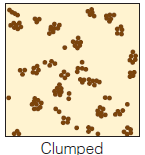
61
New cards
uniform population dispersion
individuals live specific distances from each other; results from territoriality and competition
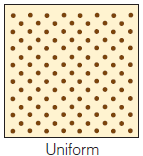
62
New cards
random population dispersion
individuals are spread randomly
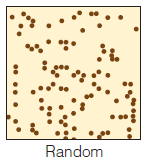
63
New cards
population growth patterns
population size changes, increasing, decreasing, or staying fairly constant
64
New cards
factors affecting population size
immigration - individuals coming into a population
births - individuals being born into a population
emigration - individuals going out of a population
deaths - individuals being removed from the population through death
births - individuals being born into a population
emigration - individuals going out of a population
deaths - individuals being removed from the population through death
65
New cards
exponential growth
J-curve; occurs when a population size increases dramatically over a period of time
-may occur when a species is introduced into an uninhabited area
-typical of bacteria and small animals
-may occur when a species is introduced into an uninhabited area
-typical of bacteria and small animals
66
New cards
logistic growth
s-curve; occurs when a population begins with slow growth, followed by a period of rapid growth, before leveling off at a stable size
67
New cards
carrying capacity
maximum number of individuals of a particular species that the environment can normally and consistently support
68
New cards
population crash
dramatic decline in the size of a population over a short period of time
69
New cards
limiting factor
the characteristic or resource that has the greatest effect in limiting the size of a population
ex. competition, predation, parasitism, disease, unusual weather, natural disasters, human activities
ex. competition, predation, parasitism, disease, unusual weather, natural disasters, human activities
70
New cards
succession
sequence of biotic changes in a community
71
New cards
primary succession
establishment and development of an ecosystem in an area that was previously uninhabited
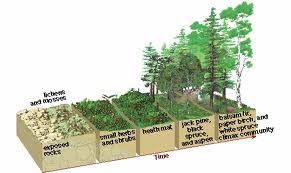
72
New cards
pioneer species
typically lichens and some mosses; first organisms that live in an uninhabited area on bare rock
73
New cards
secondary succession
re-establishment of a damaged ecosystem in an area where the soil is exposed
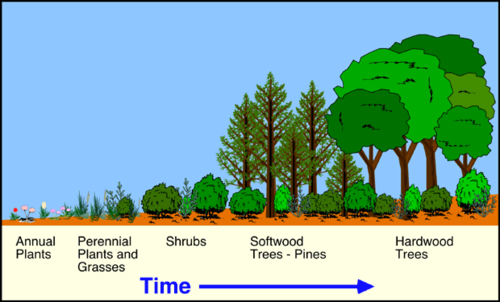
74
New cards
nonrenewable resources
a resource that is used faster than it can be reformed
ex. oil, coal, natural gas
ex. oil, coal, natural gas
75
New cards
renewable resources
a resource that can be replace at the same rate it is used
ex. wind, solar, water
ex. wind, solar, water
76
New cards
ecological footprint
the amount of land necessary to produce and maintain enough food and water, shelter, energy and waste for the population. the larger the footprint, the more negative the impact is on the ecosystem
77
New cards
pollution
any undesirable factor, or pollutant, that is added to the air, water, or soil; especially synthetic chemicals and materials added to the earth that cannot be integrated into normal ecosystem functions
78
New cards
greenhouse effect
occurs when carbon dioxide, water, and methane molecules trap energy in the Earth's atmosphere, which allows for a stable temperature so life can exist
79
New cards
greenhouse gases
CO2, H2O, CH4 - absorb heat energy in the atmosphere
80
New cards
indicator species/bioindicators
typically the first organisms in an ecosystem to be affected by pollution
81
New cards
biomagnification
-causes accumulation of toxins in an individuals' bodies in the food chain
-process in which pollutants move up the food chain as predators eat prey, accumulating in higher concentration in the bodies of predators, with the most serious effect in the bodies of the top predators
-process in which pollutants move up the food chain as predators eat prey, accumulating in higher concentration in the bodies of predators, with the most serious effect in the bodies of the top predators
82
New cards
threats to biodiversity
-loss of habitat and pollution affect animal and plant populations
-loss of biodiversity can reduce an ecosystem's stability and make it more difficult for the ecosystem to handle future change
-biodiversity is highest in rainforests in the world, which are being deforested
-loss of biodiversity can reduce an ecosystem's stability and make it more difficult for the ecosystem to handle future change
-biodiversity is highest in rainforests in the world, which are being deforested
83
New cards
habitat destruction
loss of habitat eliminates species
84
New cards
habitat fragmentation
when a barrier prevents an organism from accessing its entire home range
85
New cards
introduced species
any organism that was brought to an ecosystem as the result of human actions
-threaten the stability of ecosystems; are better competitors or are predators of native species
-cause tremendous damage to the environment
ex. fire ants, kudzu, zebra mussels, purple loosestrife, burmese pythons
-threaten the stability of ecosystems; are better competitors or are predators of native species
-cause tremendous damage to the environment
ex. fire ants, kudzu, zebra mussels, purple loosestrife, burmese pythons
86
New cards
conservation practices
-laws that protect endangered or threatened species also protect their habitat and other organisms around them
-control how fast our population grows by controlling birth rates
-develop technology to produce more food and produce less waste
-change our practices and take action to protect and maintain ecosystems
-reduce or eliminate the pressures we place on the planet's biogeochemical processes
-control how fast our population grows by controlling birth rates
-develop technology to produce more food and produce less waste
-change our practices and take action to protect and maintain ecosystems
-reduce or eliminate the pressures we place on the planet's biogeochemical processes